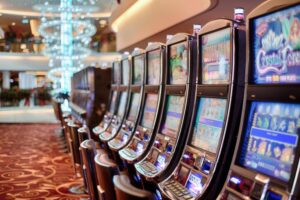Of all smartphone users, 79% check their device within 15 minutes of waking up each morning. Even more striking is that, on average, individuals unlock their phones 80 times a day. We must face it; we are addicted. The products and services we engage with are reshaping our daily actions, precisely as their designers intended. Our behavior has been premeditated. But how do technology companies, essentially crafting mere snippets of code displayed on screens, seemingly master the thoughts of their users? And what makes social media so addictively effective? I aim to explore these questions in today’s blog post.

The Hook Cycles
Nir Eyal, author of “Hooked,” outlines a model on how companies design their products to make people addicted. Through successive so-called hook cycles, types of habit-forming cycles, successful products ensure the continual return of their users. Social media platforms like Facebook or Twitter expertly utilize these hook cycles, making nearly every interaction on their sites pave its way into our brains.

Step 1: The Trigger
Everything begins with a trigger, a catalyst for behavior. Triggers are of two kinds: external and internal. We’re familiar with external triggers, like the ‘Buy Now’ or ‘Click Here’ buttons on websites. Less recognized, however, are internal triggers. These internal prompts are what truly bind us to products.
Internal triggers guide our next actions, not through an explicit directive but through a process in our minds. The most prevalent internal triggers exploit our emotions, particularly negative ones. Feelings of boredom, loneliness, frustration, confusion, and indecision often trigger a discomfort that drives us toward almost immediate and subconscious actions to quell these negative emotions. This exploitation of our psyche is precisely where product designers focus their efforts. Users finding a product that alleviates their discomfort will gradually form strong positive associations with it.
When we feel lonely, we might turn to Facebook. Or if bored, perhaps YouTube becomes our refuge. Over time, we start associating social media with fulfilling our needs subconsciously. Once a technology has forged such an association in our minds, it no longer relies on external triggers. It becomes habitual.

Step 2: The Action
Following the trigger comes the action phase in the hook cycles. This step involves the simplest behavior in anticipation of a reward. Examples include searching on Google, scrolling through Pinterest, or hitting the play button on a YouTube video..

Step 3: The Reward
The reward phase is the third step in the hook cycles. Here, social media rewards its users by solving their problem, thus reinforcing their motivation for the action taken in the previous phase. To comprehend why these rewards are so compelling, we must look deep into our brains.
The nucleus accumbens, our brain’s pleasure center, activates in anticipation of a reward. Activities like sex, enjoying good food, or shopping stimulate this brain region, driving much of our behavior. These rewards are why we check our email, browse the internet, or shop online. There are three categories of such rewards: tribe, hunt, and self.

Tribe
The feeling of belonging and being accepted by others forms the essence of the ‘tribe’ reward. Social media taps into our deep-seated desire to feel connected, valued, and recognized within a community. Platforms like Facebook excel in providing these social gratifications. Every time you log in, you’re greeted with a stream of updates, comments, and likes from your circle, making you feel part of a larger group. The unpredictability of what you might find each visit spurs the excitement to return, keeping you hooked as you seek social validation and inclusion.

Hunt
Our primal instinct to seek and acquire resources is the driving force behind the ‘hunt’ reward. In the context of social media, this translates to the pursuit of information, entertainment, or the next engaging post. The thrill lies in the unpredictability – much like a gambler at a slot machine, not knowing what the next scroll might reveal keeps us engaged. Twitter’s timeline, for example, might present breaking news one moment and mundane updates the next, yet the potential for discovering something new with each scroll makes the hunt endlessly captivating.

Self
The pursuit of personal achievement and satisfaction, or the ‘self’ reward, revolves around achieving goals that affirm our sense of competence and mastery. This is evident in how video games reward players for progressing through levels or unlocking new abilities, providing a sense of personal accomplishment. Similarly, social media platforms may not offer physical trophies, but they do offer the chance for personal expression and recognition, such as receiving likes and comments on a post, which fulfills our need for self-validation and achievement.
]
Step 4: The Investment
The investment phase is the hook cycle’s final step. The more effort and time users invest in a product or service, the more they value it. This phenomenon is encapsulated in the phrase ‘labor leads to love.’ Investing personal effort into something enhances our satisfaction with it.
A prime example is Facebook, where every update, like, photo, or video shared adds to a user’s timeline, weaving a digital narrative of their experiences and relationships. As users continue to interact and share, their digital lives are cataloged, making their collection of memories and experiences increasingly precious. The more users invest, the harder it becomes to disengage due to their substantial personal investment in the platform.
Sometimes, investment also means actively or passively adding data about oneself or one’s behaviors. On LinkedIn, for instance, a user’s online resume represents stored value, encouraging deeper engagement the more information is added.
It is clear that the investment phase encourages users to return, enhancing the product’s value with each cycle through the model. By engaging in successive cycles, users grow more attached to their experiences, becoming increasingly reliant on the product as their go-to solution, until a new habit is firmly established.

I hope this article has illuminated how social media manages to ensnare us in its addictive web. My aspiration is that we can harness the same mechanisms that make social media so engaging to create products that genuinely enhance people’s lives. However, realizing this goal starts with understanding the process of addiction, which is why I penned this article.
Note: This article includes insights from Nir Eyal’s book “Hooked.”


